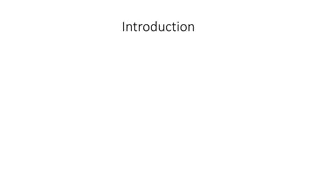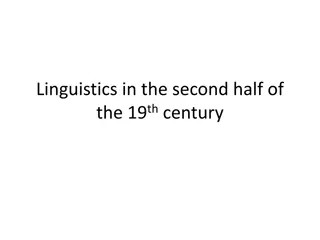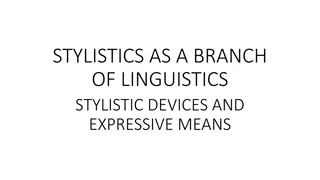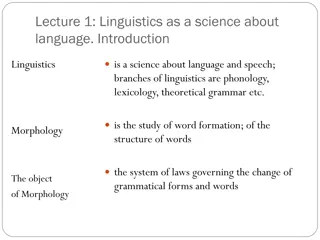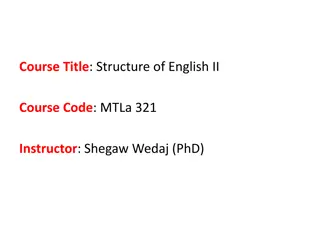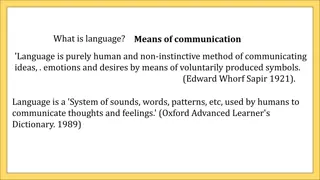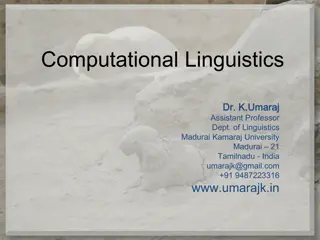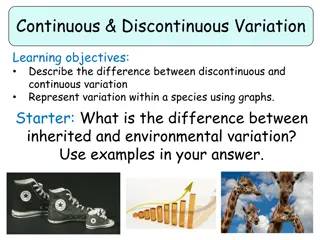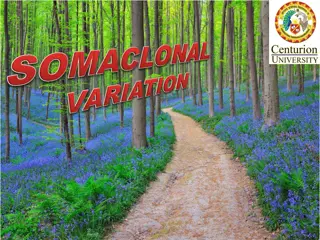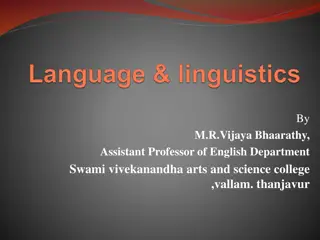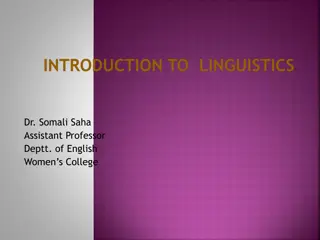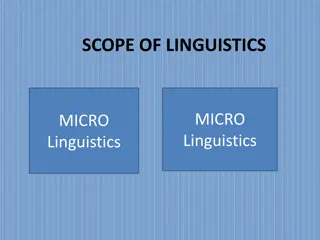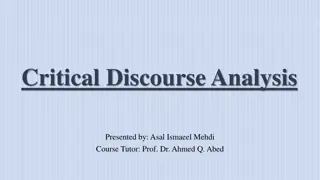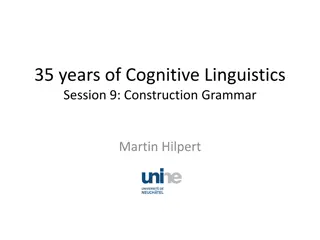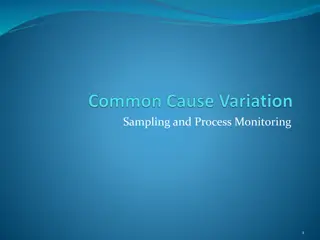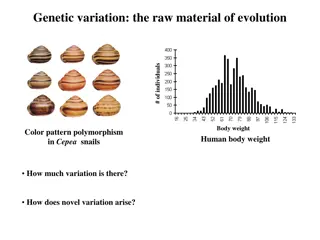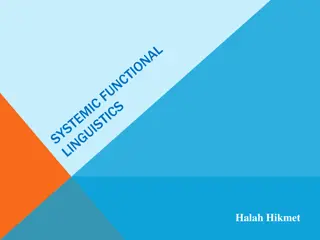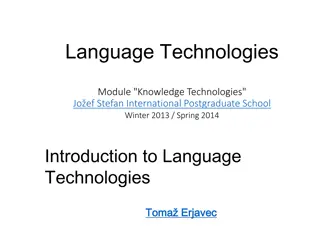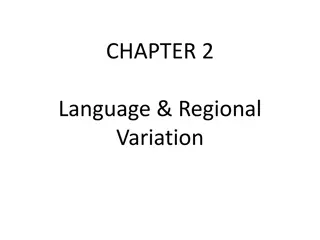Language Variation and Applied Linguistics
Delve into the intricacies of language variation, from dialects to world Englishes, while studying the practical applications in the field of applied linguistics. Discover the factors influencing language varieties and the subfields of linguistics, including phonetics and sociolinguistics. Explore how applied linguistics extends into lexicography, education, and language policy, shaping our understanding of language use in diverse contexts.
Download Presentation

Please find below an Image/Link to download the presentation.
The content on the website is provided AS IS for your information and personal use only. It may not be sold, licensed, or shared on other websites without obtaining consent from the author.If you encounter any issues during the download, it is possible that the publisher has removed the file from their server.
You are allowed to download the files provided on this website for personal or commercial use, subject to the condition that they are used lawfully. All files are the property of their respective owners.
The content on the website is provided AS IS for your information and personal use only. It may not be sold, licensed, or shared on other websites without obtaining consent from the author.
E N D
Presentation Transcript
SECTION 1 ... .Page Introduction 1.1 Why Do We Use Different Languages?...........................2 1.2. What Is Language?..........................................................8 1.3. What Is Linguistics ?.......................................................22 1.4. What Is Applied Linguistics ... .....27 1.5. Difference Between Linguistics And Applied Linguistics ...51 SECTION 2 Language variation ...... .56 : .... 2 :
: 2.1. Factors for Language Variation ......... . ...57 2.3. Kinds of Language Varieties ........... ...65 2.3.1. Dialects vs. Accents vs. Styles (1)Accent ................................ .65 (2) Language and Dialect ......................... .77 (3) Styles ............ ..90 2.3.2. Registers ............ .91 2.3.3. Diglossia ........... .92 2.3.4.Idiolect ........... 92 2.4. NON-NATIVE VARIETIES AND WORLD ENGLISHES ................. .94 2.5. Pidgins and creoles .......... .97
22 - 34 1.3. WHAT IS LINGUISTICS ? Page 22 - 24 1.3.1. Linguistics as a Science - linguistics is the scientific hypothesis. -This is falsification. - Consider this example .. thus falsifies it. -there is a common . languages. - being a polyglot .. is not a requirement 1.3.2.The Subfields of Linguistics See book Page25- 26 - Phonetics deals . and translation. and translation.
To sum, we dare say that: see book 26-27 -2.Linguistics is the structure - 3. Linguistics is the structure . - 4. Its goal is . their language - 5. Linguistics examines . aspect , which are universal -how individual .. born". - 6. Like all levels: - 2)Applied community. 1.4. WHAT IS APPLIED LINGUISTICS see page 27-34 - Professors Charles . learning.
1.4. WHAT IS APPLIED LINGUISTICS see page 27-34 - Professors Charles . learning. - 2. General linguistics . Languages - It analyses theoretical linguistics .. Systems See the book page 29-33 Sociolinguistic . Contexts. Psycholinguistics . human behavior). Corpus linguistics ..applications. The task of applied ..applications. 2) The term applied linguistics ..findings of general linguistics -For many, applied linguistics is general linguistics. 1.4.1. Autonomous applied linguistics justice. Applied linguistics draws on theory, ..methods and inputs.
35 - 41 A.L. extends into such practical application fields as as:See Book Page 35-38 Lexicography .education. Machine Translation ( computerized translation ) Computational Linguistics (the use of computers in language analysis and use) Language assessment (to measure student learning of languages, to determine what a student knows and/or can do . Language Policy and Planning The practical .instruction. Language pedagogy (theory of .that data. Anthropology (the scientific of man.
Internet linguistics ( It (SMS). Text Analysis ( written Language Control / discourse). Dialectology (study of .on geographic . 1.4.3. History of Applied Linguistics See book page 39-41 The term (1942). In America Michigan . In Britain ..Ferguson in1959. The Australia tradition of AL shows a strong influence of continental Europe and of USA . The British Association of Applied Linguistics (BAAL) was formally established in 1967 . --- -The British tradition . aspects of linguistics. -Applied Linguistics looks out beyond .intending to correct them.
41 - 54 1.4.4. Defining Applied Linguistics See the book page 42-48 -Schmitt and Celce-Murcia (2002:1) say that: . world. -They explain the two. -Christopher Brumfit . in applied linguistics. 1.4.5. Applied linguistics as an interdisciplinary discipline -AL is a branch .. area of language study. -Douglas L. Rideout .. and lexicography . -Over the past decade on the other. -As a result , . real-world contexts. 1. Applied linguistics has many .. become applied linguists. 2. AL has conferences with well-defined subareas. - 3. Applied .. training and work.
4.Applied linguistics main and sociology. 8. Applied linguistics is not AL research. Applied linguistics . are applied linguistics The International Association . work on these problems -The problem-solving complex and multi-faceted. -Sheer description of any area of language is not Applied Linguistics as such but descriptive linguistics.
51 - 59 - 1.4.6. Applied Linguistics as a Problem-solving Approach See the book Page 49-54 - Applied Linguists have to be clear that they are solving problems within an area of language use. - The problem-solving successes . language teaching. - 1. The Applied Linguist is a Jack to their concerns. - 2. The Applied Linguist is a go-between .. multi-faceted. - Sheer description .. descriptive linguistics. - 1.5. DIFFERENCE BETWEEN LINGUISTICS AND APPLIED LINGUISTICS : - 1. Linguistics is .. communication. - 2. Linguistics is a .. concrete speech situation . -How Linguistics is related . (Discourse Analysis). -5. Elementary . and speech. -6. The secondary . and phonology 8. The Antropologist: culture. 9. The Psychologist: . behaviour ( psycholonguistics) 10. The Sociologist . terminology.
56 - 64 Language variation See the book page 56- 64 -2.1. Factors for Language Variation -One side of .. change. -(i) Settlement: Settlement generally . social groupings. (ii) Geographical Factors: - Geography plays a role in the development of dialects. ... is face-to-face interaction, (iii) Language Contact: Contact with speakers .. language development (iv) Economic Ecology: Different and pronunciation.
(vi) Social Interaction and Social Practices: -At the individual . variables. (2) Linguistic Factors: -Under linguistic is born. 2.2. Language Variation And Social Judgement the English language .. upper classes. Authority in language -The notion of to discrimination . -Noam Chomsky actual performance Language judgements In linguistics, a variety . linguistically speaking. -Received Pronunciation (RP) its rarity.
65 - 80 2.3. Kinds of Language Varieties -Accent .. Jargon What is an accent? A manner in a person's language. English, a world language . but rather many American English accents. -Accents may become particularly . native speaker. So, What is an accent?......... of another one. Therefore, accent is: principally by region. 3. In sociolinguistics .. a foreign accent). Social factors: Prestige : Certain . upper class. (2) Language and Dialect What is a dialect? See the book page 77- -A regional variety of a language with differences in vocabulary, grammar, and pronunciation How do dialects differ?........ most languages represents a dialect. -Thus, the dialects prevalence and prominence -The other usage unsuitable for writing
82 - 100 -Dialectal variation -Dialects of the specific language vocabulary, and grammar. Types of Dialects :Regional and Social Dialects -1. Regional Dialects . Dialectology. -2. Social Dialects . members of the group. -3. Occupational Dialects . mining and so on. -Prestige Dialects .. speech patterns. Standard and non-standard dialect .
Standard and non-standard dialect. New England English and, Cockney. 1.Mutual intelligibility be different languages. 3.Political factors often standardised, variety. Distinctions Between Dialect and accent someone's use of language. -An accent is someone else s have social implications (3) Styles -Styles generally refer conversation taking place 2.3.2. Registers Register refers to social repertoire. 2.3.3. Diglossia . or purposes 2.3.4.Idiolect in their discourse. 2.4. NON-NATIVE VARIETIES AND WORLD ENGLISHES .. -World Englishes refers .or competence in, the language. -lingua franca (When a language is used as a medium of communication between speakers of different languages, it is known as a lingua franca)
2.5. Pidgins and creoles - A simplified language derived .. is very simplistic. - Put simply, Put simply, - Differences between Pidgins and Creoles: . become a first language. - 2) Structural difference . often found in Pidgins. - Pidgins are very basic .. on superstrate vocabulary. - MCQ -


